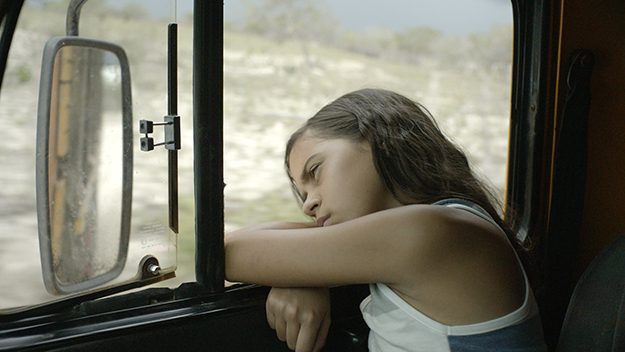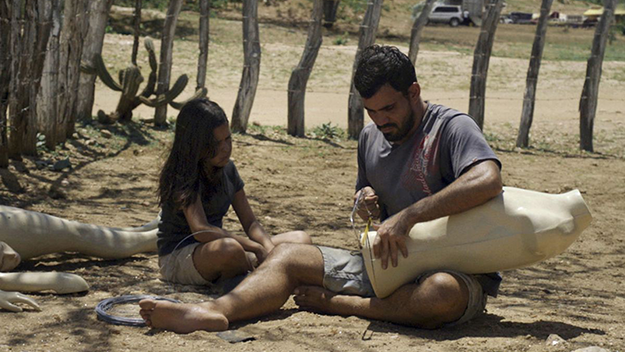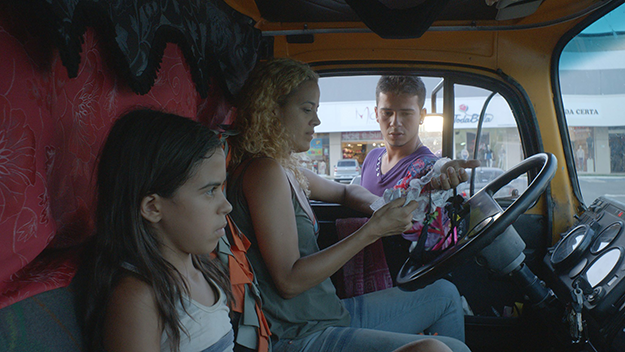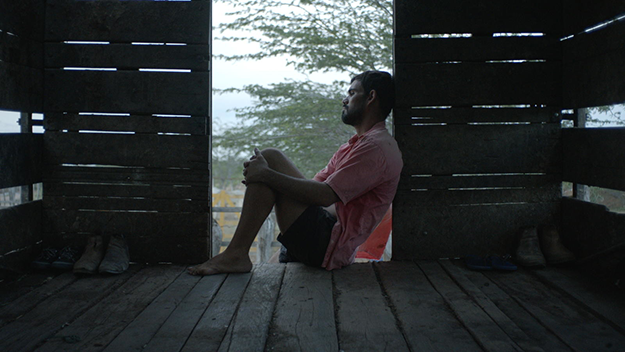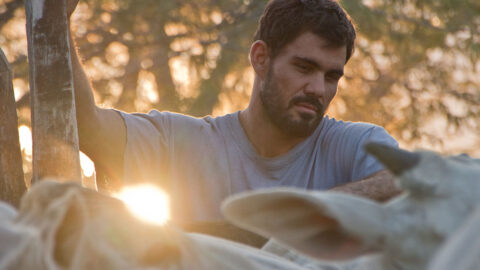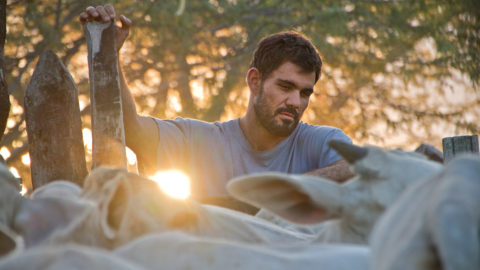Film of the Week: Neon Bull
Gabriel Mascaro’s Neon Bull is one of those films that plunge you into a world that seems profoundly strange, even though it’s fairly clear that pretty much everything in it is derived directly from the real. The Brazilian director (interviewed here by Violet Lucca) has just been the subject of a Film Society of Lincoln Center retrospective including his documentaries; Neon Bull fascinatingly straddles the adjacent areas of fiction and the seemingly immediate representation of an actual, extremely specialized milieu.
Mascaro’s fiction debut August Winds (14) was set in Brazil’s Northeast, and starred a nonprofessional cast. His follow-up, Neon Bull, stays in that same geographic area and evokes the lives of workers in a travelling vaquejada or traditional rodeo, and its characters seem so completely a part of that world, and so attuned to the body language that belongs to it, that we assume they all are the real thing, although they are largely professional actors. As for exactly how much is realistic in Neon Bull, that’s hard to know, though it’s tempting to imagine that the film’s strangest images—like a woman dancing on stage wearing a skin-tight costume, hoof-like boots and a horse’s head—are taken straight from reality. You somehow hope they are.
This is an “alternative family” film, about a group of people whose intimacy arises from their living conditions and a shared trade in an enclosed world. Iremar (Juliano Cazarré) is a cowboy, one of three men who travel in a truck from rodeo to rodeo, carrying a herd of white bulls, to be wrangled to the ground by horse riders. It’s hard to know exactly what the financial reward for such work is, or how specific technical know-how functions—for some reason, dusting the bulls’ tails with sand seems crucially important—but this milieu’s strangeness quickly comes to feel familiar, just by virtue of Mascaro immersing us so completely in its daily details and textures. At the start of the film, we’re immersed in a very literal way: a slow tracking shot presents us with what seems a solid wall of dusty white flesh, before we realize we’re seeing the bulls packed in their pens. The soundtrack of snorts and moos over the opening credits is pretty immersive too, and unsettling.
Also part of the rodeo family is Galega (Maeve Jinkings, from Kleber Mendonça Filho’s Neighboring Sounds). It’s hard to tell exactly what her role is—she’s a tough, serious figure, part den mother, part resident mechanic, seen at work under the group’s truck. But she’s also the one doing those sexy post-rodeo dances for crowds of enthusiastic men—and Iremar, whose dream is to work in the clothing industry, likes nothing better than to design and sew her costumes. Galega is also mother to a young girl, Cacá, whose father is referred to but absent. Mother and daughter have a testy relationship which erupts in a tense spat, shot in a long take in the front of the truck, just after Galega has bought a fistful of G-strings from a flirtatious salesman. Sex and long takes, as we’ll see, are high on Neon Bull’s film’s agenda.
Cacá, played by Alyne Santana—whom Mascaro invited to improvise and to be silent when she preferred to—is in many ways the center of the film’s energy and its emotional economy. While the adults around her fend for themselves in a fairly self-contained, taciturn way, she needs to talk and be talked to, and yearns for parenting, biological or surrogate. Her vulnerability and vivacity galvanize two scenes in particular, one where she asks Iremar to hug her—which he does at length, with cautious fatherly gentleness—and another where she’s larking around knee-deep in cattle feed with another cowboy.
Neon Bull gives you the sense of being initiated into a world with its own rituals that you have to learn, the actors helping induct you by example into its mysteries. Recent similar examples include the docufiction hybrids of Roberto Minervini, whose own Texan rodeo film Stop the Pounding Heart used members of a family as actors, seemingly playing themselves; the work of Jean-Charles Hue (La BM du Seigneur, Eat Your Bones), again using real family, this time from a French Roma community; and Clio Barnard’s The Selfish Giant, depicting a somewhat arcane form of trap racing peculiar to certain parts of Northern England.
Does the real vaquejada world involve women dancing in horse’s heads, or bulls glowing bright green under day-glo lights? We can only assume it does—and if not, then Mascaro’s invention is truly inspired. Certainly, the world he depicts—not just the rodeos but the landscape around them—is larger than life to the point of being hallucinatory, and a real gift for Mexican DP Diego García (who went on after this shoot to do further extraordinary things with neon tones in Apichatpong’s Cemetery of Splendor). One scene shows us glossily illustrated billboards advertising celebrity horses, another has a rock in the middle of a desert painted blue to resemble a trompe l’oeil ocean wave.
The world of Neon Bull is, as you’d imagine, one of intense carnality—with the term implying not just the realm of the physical, but also meat, pure and simple. Star attraction at a horse auction is top breeding mare “Lady Di,” trotted on to the accompaniment of “God Save the Queen.” Meanwhile, backstage, Iremar and tubby sidekick Zé (Carlos Pessoa) are sneakily trying to jerk off a stallion to steal its semen; this scene, which graphically leaves the horse’s enthusiasm in little doubt, ends with the sort of messy payoff you might expect in a Will Ferrell or Melissa McCarthy vehicle, yet here the comedy is entirely natural, emerging organically from the sort of situation that’s presumably an everyday factor in this world.
In fact, I can’t remember any recent film in which sex was at once so prominent and yet treated so matter-of-factly: Iremar appropriates a men’s magazine from Zé in order to sketch his costume designs on the nudes, and it’s no big deal if the pages are stuck together from previous use. For that matter, it’s hard to remember any movie in which sex was so tender and clearly a pleasure for those involved. In one scene, a new cowhand goes down on Galega outside at night; their naked bodies gleam in the dark, framed in long shot against a wall of ruminating bulls, the light reduced to vertical streaks on the flanks of both humans and animals.
In a later scene, Iremar pays a visit to Geisy (Samya de Lavor), a friendly young woman whom we’ve previously met selling perfume, Avon-style, round the cattle pens. At night she’s a security guard at a clothing factory that specializes in women’s underwear. As she walks him around the workshops, his eyes light up at the state-of-the-art equipment; “Ave Maria!” he exclaims, like a model railway enthusiast seeing a particularly fancy layout. Then, in a nearly wordless unbroken eight-minute take, they kiss, undress each other, and make love on the table, their bodies again glinting in the dark; appropriately, she ends up in what’s known as the Reverse Cowgirl position. It’s a genuinely sexy and resonant scene, partly because of the particular gender inflections: he’s a masculine, even macho working man, but with what would often be considered a feminine fascination with clothes and their manufacture; she’s a gun-carrying security guard, but also very visibly pregnant. The wordless way that they click suggests a sexual telepathy, there’s real tenderness in their sounds and movements, and the characters (and for all we know, the actors) seem to be having a really good time—which is still, strange as it seems, something of a rarity when it comes to sex in art cinema.
Throughout the film, Neon Bull draws our attention to the fleshiness of flesh—to the fact that human and bovine bodies alike are material, ultimately meat. The penultimate shot even shows a bull, cow, or calf reduced to a sizzling piece of meat on a spit. But while films that highlight carnality so often deliver messages of memento mori glumness, here we constantly get sense that while bodies are alive, then they’re alive, and irreducibly so.
The bulls in this story are white, bony, oddly innocent-eyed in their blankness, and resemble the sacred cattle of India. They’re never presented as a metaphorical holy presence, but a life force they certainly are: in an extraordinary shot, they come leaping out of the back of the truck like a flood, a liquid cascade of cattle. Mascaro may not equate the bovine with the divine, but the sheer energy of being is here, kicking and mooing for all it’s worth.
Jonathan Romney is a contributing editor to FILM COMMENT and writes its Film of the Week column. He is a member of the London Film Critics Circle.



